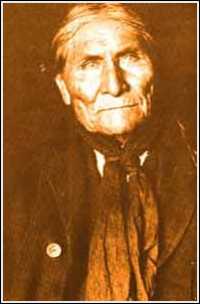|
|
|
| Geronimo was an Apache leader. He made many raids in the southern states and Mexico. He was a medicine man, not a chief. Yet his visions made him indispensable to the Apache leaders, who gave him a prominent position among the Apache. | |
| Geronimo was born in No-doyohn Canon, Arizona, in June of 1829. He belonged to an Apache tribe called Be-don-ko-he. They lived west from the eastern border of Arizona and south of the Gila River. When he was young, he took part in the forays of the other Apaches. When he was a bit older he married a young Chiricahua named Alope. Geronimo had to give a herd of ponies to Alope's father for her hand. They had three children and lived in a large tepee together. | |
| In the summer of 1858, Mexican troops attacked an Apache camp named Kas-ki-yeh and killed the warriors of the guard, many women and children, destroyed supplies, captured most ponies, and secured all arms. Geronimo's wife, mother, and three children were among the slain. The murder of his family changed his and southern settler's lives forever. They remaining Apache started marching to their own settlement. It took them two days and three nights to reach the border. The stopped at the border for two days to rest and hunt. When Geronimo arrived at his own settlement, he burned down his tepee. He also burned down his mother's tepee and children's playthings. He said, "I was never again contented in our quiet home." He then vowed his vengeance upon the Mexicans who killed his family. Geronimo went to two other Apache tribes to see if they would join him in a march against the Mexicans. Both promised their help. | 
Geronimo when older. |
|
In 1859, almost one year from the massacre of Kas-ki-yeh, the three tribes marched to Mexico. The families of the warriors were hidden in a camp in the mountains. The tribes marched in three different divisions. Each tribe was a different division. They marched about fourteen hours a day, making three meal-stops. They traveled an average of forty miles a day. When they were outside of Arispe, a Mexican town, they camped. Eight men came from the city to parley. The Apache captured, killed, and scalped all eight to draw the soldiers out of the town. The next day the troops attacked. The Apache dominated the troops. The next mourning at ten o'clock, the whole Mexican force attacked. There were two regiments of cavalry and two of infantry. The Apaches were again victorious. Geronimo was made war chief of all Apache. He later said, "I could not call back my loved ones, I could not bring back the dead Apaches, but I could rejoice in this revenge." |
|
| In 1876, the Apaches were sent to San Carlos Agency in New Mexico. Geronimo led a group of followers into Mexico. From then on for ten years, Geronimo and his band raided New Mexico, Arizona, and northern Mexico. They were eventually captured and sent back to the new reservation. There he became a prosperous farmer until he escaped in 1881 with his band. He made more raids in Arizona and Sonora, Mexico. He surrendered two years later in 1883 to General Crook. He was again returned to the new reservation. Then, in 1885, Geronimo left again. In May, Crook sent out one hundred scouts and twenty troops of cavalry after Geronimo and his band into Mexico. On the seventeenth of May, 1885, warriors killed Briton Davis and an Apache scout. After almost a year of war and raids, Geronimo agreed to surrender to Crook, but fled at the last minute. | |
| In November and December of that same year, a band of ten Apache raiders swept across the South, killing thirty-eight people and stealing around 250 horses and mules. Geronimo was blamed. On March 25, 1886 in Canon de los Embudos, the Indian chiefs and Geronimo talked to General Crook about surrendering. Geronimo told Crook, "It would be better if you would speak to me and look with a pleasant...... I would be better satisfied if you would talk to me once in a while. Why don't you look at me and smile at me?" Geronimo didn't surrender. | |
| On September 4, 1886, Geronimo and his group of followers were captured at Skeleton Canyon by General Miles, Crooks successor. Geronimo then said that he "quits the warpath and lives in peace hereafter." Geronimo's surrender marked the end of centuries of warfare between Euro Americans and the desert Indians. The next day, General Miles sent Geronimo to a prison. They were then transported to Florida as prisoners-of-war. They were not allowed to take their families with them. From the prison in Florida, Geronimo's band was to be sent to Fort Marion, in St. Augustine. However, they were sent to Fort Pickens, in Pensacola. They arrived at Fort Pickens on October 25, 1886. Geronimo was considered a tourist attraction there. He had over 459 visitors with an average of twenty visitors a day. | |
| After
prison in Florida, he was taken under military confinement at Fort Sill,
Oklahoma. There he settled down, adopted Christianity, and became a
farmer. In his later life, Geronimo visited the St. Louis World Fair
in 1909. He made a great deal of money signing autographs and
photographs. He became a national celebrity when he appeared in
Roosevelt's inaugural procession. Geronimo died on February 17,
1909, after he laid in the middle of the road all night , drunk, in a
freezing rain. The captivity of the Chiricahuas ended four years
later in 1913.
|
|
|
Jeff Badura 8th American History Rossville Junior High Plains History Project 2004
|
Bibliography |
